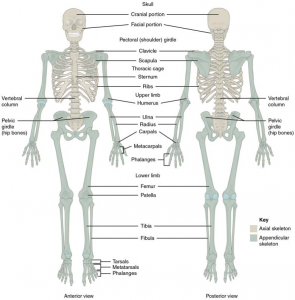The skeleton is subdivided into two major divisions—the axial and appendicular. The axial skeleton forms the vertical, central axis of the body and includes all bones of the head, neck, chest, and back (Picture 1). It serves to protect the brain, spinal cord, heart, and lungs. It also serves as the attachment site for muscles that move the head, neck, and back, and for muscles that act across the shoulder and hip joints to move their corresponding limbs.
The axial skeleton of the adult consists of 80 bones, including:
- The skull, formed by 22 bones;
- The vertebral column: the vertebral column consists of 24 bones, each called a vertebra, plus the sacrum and coccyx.
- The thoracic cage: The thoracic cage includes the 12 pairs of ribs, and the sternum, the flattened bone of the anterior chest.
- Also associated with the head are an additional seven bones, including the hyoid bone and the ear ossicles (three small bones found in each middle ear).

